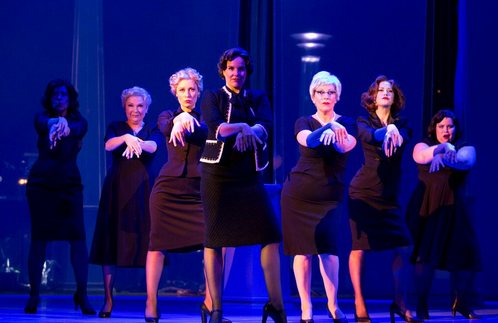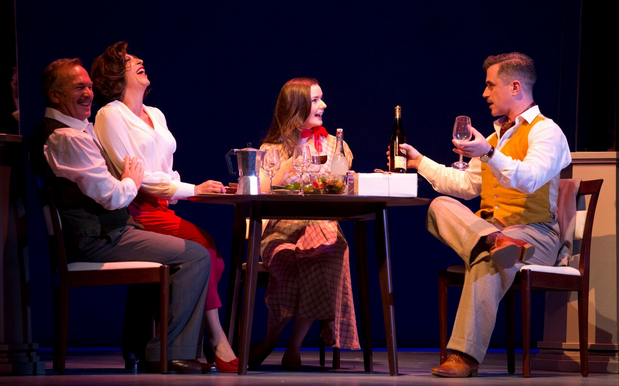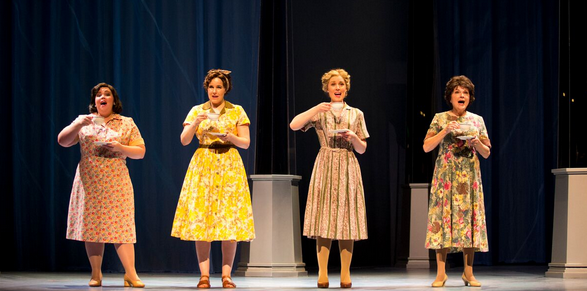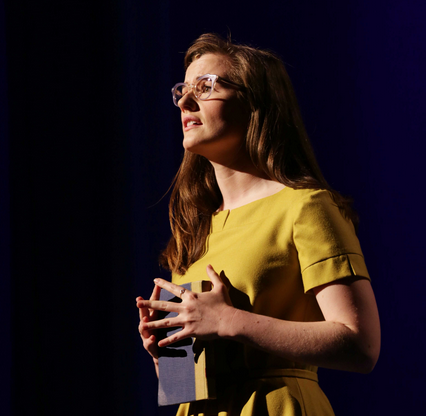Carolyn Burns and Tim Finn’s relatively new musical Ladies in Black for Queensland Theatre won a Helpmann for Best New Australian Work and has received glowing reviews on previous outings in Brisbane and Melbourne. Now, the openhearted show set in a Sydney department store in the 1950s, comes home to the Emerald City with a run of performances as part of Wesley Enoch’s 2017 Sydney Festival prior to a national tour. It’s a work with warmth, affection and a pertinent light to reflect on modern day politics of gender, refugees and nationality. It is helped by beautifully crafted performances from a standout cast making its case as strongly as possible. A pity then that it is let down by some plodding dramaturgy (especially in the overlong first half) and lyric writing that is patchy to say the least.

Madeleine St John’s novel of the same name tells the believable and diverse stories of the women who work in the cocktail frock department at Goodes, a Sydney store where the ladies behind the counters are chicly attired in black and are expected to come across in a manner as sophisticated as their customer’s social aspirations. Fay (the warmly sympathetic Ellen Simpson) is a 29-year-old orphan with a dubious past and, despite the lame efforts by her pal Myra (one of several enjoyable comic portrayals by Kathryn McIntyre), fears she is on the shelf. Patty (movingly played by Madeleine Jones) has seen the sex drop out of her 10-year marriage to the haplessly unreconstructed Frank (a stolid Tamlyn Henderson). Now tests suggest their childlessness may be his fault, not hers.
Into their department comes Lesley, who wants to be called Lisa (the engagingly gawky Sarah Morrison), a bookish schoolgirl taking a holiday job while she waits for her school leaving exam results. Lisa wants to be a poet and go to uni but her stuck in the past dad (a chameleon-like Greg Stone who doubles masterfully as a spicy Hungarian husband) thinks otherwise. Her mum (a nicely nuanced performance from Carita Farrer Spencer) is torn between her daughter’s intellectual aspirations and the fear of losing her. Add to the mix the magical Magda, the sophisticated, slightly terrifying Hungarian refugee who runs the high-end model gown department (an award-winning, Lotte Lenya-channelling turn by Natalie Gamsu). Spying an independent intelligence, she takes Lisa under her very European wing giving the young girl an opportunity to glimpse new vistas and realise where her dreams might lead her given half a chance.

Add to this Kate Cole’s razor-sharp profit-loving manageress, Miss Cartwright, Trisha Noble’s heart-breaking “Miss” Jacobs (no one has learned her first name in 40 years), wistfully dancing with the ghost of her lost digger love at a solitary Christmas lunch, and Bobby Fox’s high-energy, over-the-top romantic immigrant Rudi, and you have a fine cast equipped to draw out the interweaving strands of St John’s delicate narrative.
As most of the creative team admit, it’s unusual fodder for a musical. There’s nothing that’s life or death about any of this, and Lisa’s journey, while mind-expanding for the character, simply takes her from an anticipated successful exam result to what we always guess will be her ticket to university. Patty and Fay have more gripping tales to tell, but the decision to musicalize each one of such a diverse range of different characters lends the show a slightly bitty quality. The modest cast size and current lack of a decent opening number (or any appropriately high-octane company number, really) saps too much dramatic energy early on. The first act could do with losing 15-20 minutes.
On the writing side, Carolyn Burns has done a fine job creating believable dialogue that moves her characters forward. It’s quintessential Sydney, full of amusing references to life in the harbour city, and it’s great to see a musical with such an array of strong female characters. Burns has differentiated them perfectly, and along with director Simon Phillips, she has tightly integrated the text with the music wherever possible. Phillips works hard to achieve an efficient staging, with focus on individual storylines that are given plenty of room to breathe emotionally. Andrew Hallsworth’s decent choreography isn’t to his very highest standard, relying too much on period cliché, but it’s great to see a cast of actors of all shapes, sizes and ages carry it off with such aplomb.

Less successful are the music and lyrics by legendary singer/songwriter Tim Finn. It’s his first musical, and while his tunes are pleasant enough – most have hooked you in well before the end of each song, though few linger with you afterwards – too many of them show a lack of experience in carrying r drama forward through music in real time. Phillips well-fashioned production helps where it can, but songs can drop the dramatic ball badly with actors left emotionally unsupported by musical momentum.
Worse still is some of the lyric writing. In the past, Finn has proven a master of representing a raft of feelings obliquely though song, so it’s surprising that here he so often writes such blunt expressions of feelings in many of his solo numbers. More ambiguity at times might help, but certain numbers, like Frank’s “I’m sterile” song, are likely lost causes. Not all lyricists need to be a Sondheim, of course, but a sense of subtext and more discipline and attention to craft wouldn’t come amiss.
It’s not all bad. Numbers like the rap-infused Sales Talk with its catchy walking bass, the enjoyable teacup clinking Bastard Song, the fizzing I Just Kissed a Continental and the show’s title number indicate where Finn’s talents might lead him. His jazz-inflected score is sweet, with suggestions of the 1950s and 60s, but in its meandering way jazz is never a great driver of drama and therein may lie some of the problems. It’s nevertheless well played by a six-piece band under Musical Supervisor Guy Simpson and put across nicely in Michael Waters’ sensitive sound design.

Visually Gabriela Tylesova’s stunning costumes have captured the era perfectly with her attention to period detail and some immaculately tailored 1950s gowns. On the other hand, her stage design – half a dozen deco pillars and a gauze curtain – feels under resourced. David Walters does what he can lighting a tricky, diffuse set. The Lyric is a big, unforgiving space, and at times the show feels uncomfortably small (it may well have felt punchier in previous incarnations). It is at its best in the tight domestic scenes revealing Lisa and Patti’s home lives, or when the stage is filled with the larger-than-life Magda and her ravishing model gowns. At other times, it could use a visual lift.
A new Australian musical is always a bit of a great white hope and, although I can’t see it making waves on Broadway, Sam Strong’s Queensland Theatre deserves kudos for its ambition, faith and passion for the form. If Ladies in Black feels at times undercooked and short on musical and lyrical craft, it scores with its neatly done book and its stellar, hard-working cast (several Helpmann nominations here, I’d reckon). The show certainly has plenty of heart, and the ways in which Lisa impacts on the lives of those around her are never less than engaging. If I perhaps didn’t enjoy it as much as I’d hoped, I could see plenty of others who had liked it better. Worth a look.
Ladies in Black is at Lyric Theatre, Sydney, Jan 3 – 22; QPAC, Brisbane, Jan 28 – Feb 19; Regent Theatre, Melbourne, Feb 25 – Mar 18; Canberra Theatre Centre, Mar 27 – Apr 2.











Comments
Log in to join the conversation.